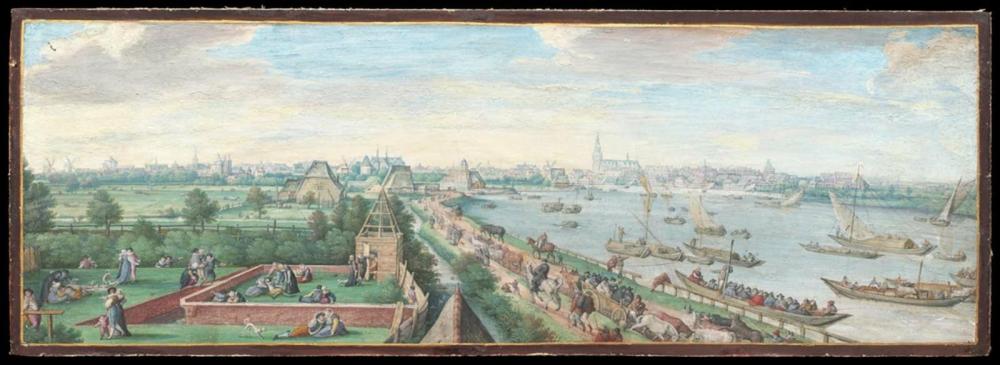Advanced Search 

View of Amsterdam from the South
Hans Bol (Netherlandish, 1534–1593)
1589
Medium/Technique
Gouache, heightened with gold, on vellum laid down on panel
Dimensions
11.7 x 31.1 cm (4 5/8 x 12 1/4 in.)
Credit Line
Gift of Rose-Marie and Eijk van Otterloo in support of the Center for Netherlandish Art
Accession Number2017.4201
CollectionsEurope
ClassificationsPaintings
Provenance1938, Alphonse de Rothschild (b. 1878 – d. 1942) and Clarice de Rothschild (b. 1894 – d. 1967), Vienna; 1938, confiscated from Alphonse and Clarice de Rothschild by Nazi forces (no. AR 3358) [see note 1]; taken to the Kunsthistorisches Museum, stored at the Central Depot, Neue Burg, Vienna, and selected for the Führermuseum, Linz [see note 2]; 1941, removed to the monastery of Kremsmünster (KG 277) and subsequently to Alt Aussee; 1945, recovered by Allied forces; by about 1947, returned to Clarice de Rothschild, New York [see note 3]. Jacob Theodor Cremer (b. 1902 - d. 1979), Darien, CT and Mount Kisco, NY; November 17, 1980, Cremer estate sale, Sotheby Mak van Waay, Amsterdam, lot 32 [see note 4]. By 1997, private collection, Belgium [see note 5]. 1997, sold by Noortman Master Paintings, London, to Eijk and Rose-Marie van Otterloo, Marblehead, MA; 2017, gift of Eijk and Rose-Marie van Otterloo to the MFA. (Accession Date: December 14, 2017)
NOTES:
[1] With the Anschluss, or annexation of Austria to Nazi Germany in March, 1938, the possessions of Alphonse and Clarice de Rothschild were seized and expropriated almost immediately by Nazi forces. This painting appears in a Nazi-generated inventory of 1939 as no. AR (Alphonse Rothschild) 3358: "Rechteckiges Gouachebildchen auf Pergament, Blick auf Haarlem, Holländisch, 17. Jhdt." Katalog beschlagnahmter Sammlungen, inbesondere der Rothschild-Sammlungen in Wien, Verlags-Nr. 4938, Staatsdruckerei Wien, 1939, Privatarchiv, reproduced in Sophie Lillie, "Was einmal war: Handbuch der enteigneten Kunstsammlungen Wiens" (Vienna, 2003), p. 1107.
[2] The Führermuseum, the art museum Adolf Hitler planned to build in Linz, Austria, was given right of first refusal over the confiscated Rothschild collection, and this painting was selected for inclusion (as "Hans Roll [sic], Holl[ändische] Hafenlandschaft, sign. dat. 1532 [sic]"). National Archives and Records Administration, College Park, MD; Microfilm Publication M1946, Roll 140, Records Concerning the Munich Central Collecting Point, 1945-1951, Linz Museum: Inventory by Accession Number. There is, however, no indication in Lillie 2003 (as above, n. 1) that this was selected for Linz.
[3] Many works of art stored elsewhere by the Nazis were moved to the abandoned salt mines of Alt Aussee in Austria, to be kept safe from wartime bombing. Allied troops recovered the looted artwork at the end of World War II, and established collecting points where the art could be identified for restitution to its rightful owners. In 1947 Clarice de Rothschild visited the salt mines at Alt Aussee, where she was able to identify the crates of works of art from her family’s collection, facilitating its return shortly thereafter. This gouache does not appear on postwar lists of works of art that had not been restituted to the Rothschilds (kindly confirmed by the descendants of Clarice de Rothschild). It is presumed to have been sold in New York around 1950.
[4] As View of Middelburg. There is no indication in the catalogue of when or from whom Cramer acquired it, but the introductory essay suggests he was building his collection from sources on the New York market after World War II.
[5] Dawn of the Golden Age: Northern Netherlandish Art, 1580-1620 (exh. cat., Rijksmuseum, Amsterdam, 1993), p. 518, cat. no. 196.
NOTES:
[1] With the Anschluss, or annexation of Austria to Nazi Germany in March, 1938, the possessions of Alphonse and Clarice de Rothschild were seized and expropriated almost immediately by Nazi forces. This painting appears in a Nazi-generated inventory of 1939 as no. AR (Alphonse Rothschild) 3358: "Rechteckiges Gouachebildchen auf Pergament, Blick auf Haarlem, Holländisch, 17. Jhdt." Katalog beschlagnahmter Sammlungen, inbesondere der Rothschild-Sammlungen in Wien, Verlags-Nr. 4938, Staatsdruckerei Wien, 1939, Privatarchiv, reproduced in Sophie Lillie, "Was einmal war: Handbuch der enteigneten Kunstsammlungen Wiens" (Vienna, 2003), p. 1107.
[2] The Führermuseum, the art museum Adolf Hitler planned to build in Linz, Austria, was given right of first refusal over the confiscated Rothschild collection, and this painting was selected for inclusion (as "Hans Roll [sic], Holl[ändische] Hafenlandschaft, sign. dat. 1532 [sic]"). National Archives and Records Administration, College Park, MD; Microfilm Publication M1946, Roll 140, Records Concerning the Munich Central Collecting Point, 1945-1951, Linz Museum: Inventory by Accession Number. There is, however, no indication in Lillie 2003 (as above, n. 1) that this was selected for Linz.
[3] Many works of art stored elsewhere by the Nazis were moved to the abandoned salt mines of Alt Aussee in Austria, to be kept safe from wartime bombing. Allied troops recovered the looted artwork at the end of World War II, and established collecting points where the art could be identified for restitution to its rightful owners. In 1947 Clarice de Rothschild visited the salt mines at Alt Aussee, where she was able to identify the crates of works of art from her family’s collection, facilitating its return shortly thereafter. This gouache does not appear on postwar lists of works of art that had not been restituted to the Rothschilds (kindly confirmed by the descendants of Clarice de Rothschild). It is presumed to have been sold in New York around 1950.
[4] As View of Middelburg. There is no indication in the catalogue of when or from whom Cramer acquired it, but the introductory essay suggests he was building his collection from sources on the New York market after World War II.
[5] Dawn of the Golden Age: Northern Netherlandish Art, 1580-1620 (exh. cat., Rijksmuseum, Amsterdam, 1993), p. 518, cat. no. 196.
